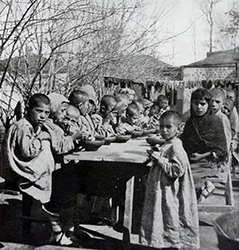14.02.2014
 This bottle, still filled with rice,
This bottle, still filled with rice,
was part of an appeal
to raise funds
for children in a Near East
[Armenian] Relief
Orphanage sometime between
1915 and 1930.
(Courtesy of Katherine Yamada
February 12, 2014)
While browsing in an antique shop in Oregon last summer, a tiny, glass bottle filled with grains of rice caught my eye. I picked it up and read the label. “The daily ration for 750 children in 1 Near East [Armenian] Relief Orphanage is 40 pounds of rice, less than 7/8 ounce per child. For lack of this small amount, they are turning children away by the thousands. Will you help?”
The label included the names of Samuel C. Lancaster as state chairman and J.J. Handsaker as director and included an address of 606 Stock Exchange Bldg., Portland, Ore. There was no date or any other information.
Intrigued, I purchased the bottle, brought it home and put it on a shelf; promising myself that I would research this artefact one day. When I discovered that the 2014 “One Book, One Glendale” program is about the Armenian Genocide, I thought of that bottle. I took it off the shelf, sat down at my computer and began searching for
“Near East Relief.”
After a few Google entries, here’s what I learned:
“Over a million and a half died as a result of deportation, forced marches, starvation and execution,” according to the website.
During the crisis,
the U.S. ambassador to Ottoman Turkey, Henry Morgenthau, assembled a group of friends and colleagues who — with the help of the -
President Woodrow Wilson — began soliciting donations from the American public.
 Armenian Orphans, eating
Armenian Orphans, eating
their rations of rice donated by Americans
The appeals were very successful, according to the website. The money raised helped save the lives of at least a million people.
By 1919, the operation had grown throughout the Middle East and West Asia and the name was changed to “Near East Relief.”
On a website for the Armenian National Institute, I found an article posted by Rouben Paul Adalian, explaining that through public rallies, church collections and assistance from charitable organizations and foundations, the Near East Relief committee raised millions in its campaign to save “the starving Armenians.”
So, it appears that this tiny bottle, still filled with rice grains that must be nearly 100 years old, was a clever appeal by two Oregon men, Lancaster and Handsaker, to aid the Armenian cause.
According to Adalian, the funds raised here in the United States were delivered through the American Embassy in Constantinople, which relied upon missionaries and its consuls to distribute the aid.
“Between 1915 and 1930, when it ended operations, NER administered $117,000,000 of assistance,” Adalian wrote. “NER delivered food, clothing and materials for shelter by the shipload from America. It set up refugee camps, clinics, hospitals, orphanages, and centers for vocational training. NER is credited with having cared for 132,000 Armenian orphans scattered across the region from Tbilisi and Yerevan to Constantinople, Beirut, Damascus, and Jerusalem.’
“Near East Relief was an act of philanthropy,” Adalian concluded, “which in the words of the American historian Howard M. Sachar, quite literally kept an entire nation alive.”
by Katherine Yamada





